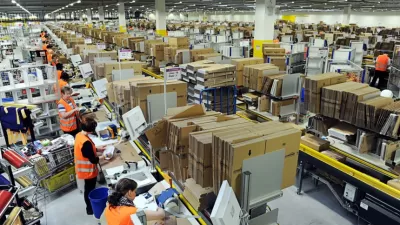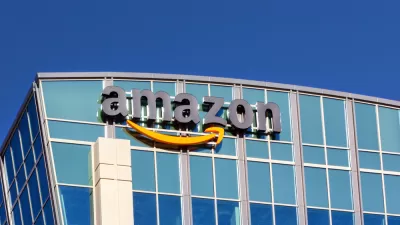Chicago warehouses were once built with architectural flair, but today’s industrial structures don’t come close.

"The next time an Amazon package arrives at your door, think of where it came from: A sprawling warehouse that’s a miracle of logistics and a piece of architecture with as much personality as a cardboard box," writes Blair Kamin.
Kamin looks back at Chicago’s long history of architecturally significant warehouses and other industrial buildings, including the Marshall Field Wholesale Store from 1887. "Designed by Boston architect Henry Hobson Richardson to sell wholesale goods, the Field store projected the austere authority of a Renaissance palace. Graceful Romanesque arches punctuated its load-bearing exterior walls, which were made of huge pieces of highly textured Missouri red granite and red sandstone from Massachusetts."
Such a commitment to quality design and materials no longer exists, Kamin laments. "The problem is that Amazon’s architects are designing cookie-cutter buildings that are the very opposite of the Chicago warehouses that engaged the streets around them, combined efficient function with powerful form, and reflected the pride of their local owners."

Planetizen Federal Action Tracker
A weekly monitor of how Trump’s orders and actions are impacting planners and planning in America.

San Francisco's School District Spent $105M To Build Affordable Housing for Teachers — And That's Just the Beginning
SFUSD joins a growing list of school districts using their land holdings to address housing affordability challenges faced by their own employees.

The Tiny, Adorable $7,000 Car Turning Japan Onto EVs
The single seat Mibot charges from a regular plug as quickly as an iPad, and is about half the price of an average EV.

Seattle's Plan for Adopting Driverless Cars
Equity, safety, accessibility and affordability are front of mind as the city prepares for robotaxis and other autonomous vehicles.

As Trump Phases Out FEMA, Is It Time to Flee the Floodplains?
With less federal funding available for disaster relief efforts, the need to relocate at-risk communities is more urgent than ever.

With Protected Lanes, 460% More People Commute by Bike
For those needing more ammo, more data proving what we already knew is here.
Urban Design for Planners 1: Software Tools
This six-course series explores essential urban design concepts using open source software and equips planners with the tools they need to participate fully in the urban design process.
Planning for Universal Design
Learn the tools for implementing Universal Design in planning regulations.
Smith Gee Studio
City of Charlotte
City of Camden Redevelopment Agency
City of Astoria
Transportation Research & Education Center (TREC) at Portland State University
US High Speed Rail Association
City of Camden Redevelopment Agency
Municipality of Princeton (NJ)




























